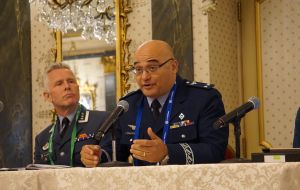MercoPress. South Atlantic News Agency
Brazil planning on a second satellite for military and civil communications
 SGDC-1 satellite launched in May 2017 carries seven X-band transponders for military communications, and 50 Ka-band transponders for broadband services
SGDC-1 satellite launched in May 2017 carries seven X-band transponders for military communications, and 50 Ka-band transponders for broadband services  “We need always to have some kind of redundancy in X-band,” Maj. Gen. José Vagner Vital said referring to the SGDC-1’s military payload
“We need always to have some kind of redundancy in X-band,” Maj. Gen. José Vagner Vital said referring to the SGDC-1’s military payload The Brazilian government is planning to purchase a second satellite for military and civil communications. Brazilian Air Force Executive Vice President Maj. Gen. José Vagner Vital, said the nation’s military wants to have a backup for the Geostationary Defense and Strategic Communications Satellite, SGDC-1.
“We need always to have some kind of redundancy in X-band,” Vital said referring to the SGDC-1’s military payload. “This means that sometimes we can buy some more capability to have some redundancy, and we are planning to launch a second satellite, hopefully in 2022. It will be SGDC-2.”
SGDC-1 launched in May 2017 on an Ariane 5 rocket. The satellite carries seven X-band transponders for military communications, and 50 Ka-band transponders for broadband services to schools, hospitals and other facilities in remote parts of Brazil.
Vital, in an interview at the 35th Space Symposium here, said SGDC-2 would also have a Ka-band payload, and, depending on the Brazilian budget, an ultra-high-frequency payload. He said current plans for SGDC-2 include feeder links in Q- and V-band, two types of spectrum satellite operators are beginning to adopt.
Vital said SGDC-2 will have an open procurement for the world’s satellite manufacturers, but there will be an emphasis on including Brazilian components.
“We are always looking for increasing local content, because we want to have our industry inside the market,” he said. “But it doesn’t mean we want to have an only Brazilian satellite. The idea is to have partnerships and go to the market with international partners.”
Thales Alenia Space of France and Italy built the first SGDC satellite with Visiona Tecnologia Espacial, a joint venture of Brazilian companies Embraer and Telebras. Vital said Visiona will likely be involved in building SGDC-2, since Visiona was created to establish a domestic geostationary satellite manufacturing capability in Brazil.
President Maj. Gen. José Vagner Vital, said the nation’s military wants to have a backup for the Geostationary Defense and Strategic Communications Satellite, SGDC-1.




Top Comments
Disclaimer & comment rulesCommenting for this story is now closed.
If you have a Facebook account, become a fan and comment on our Facebook Page!